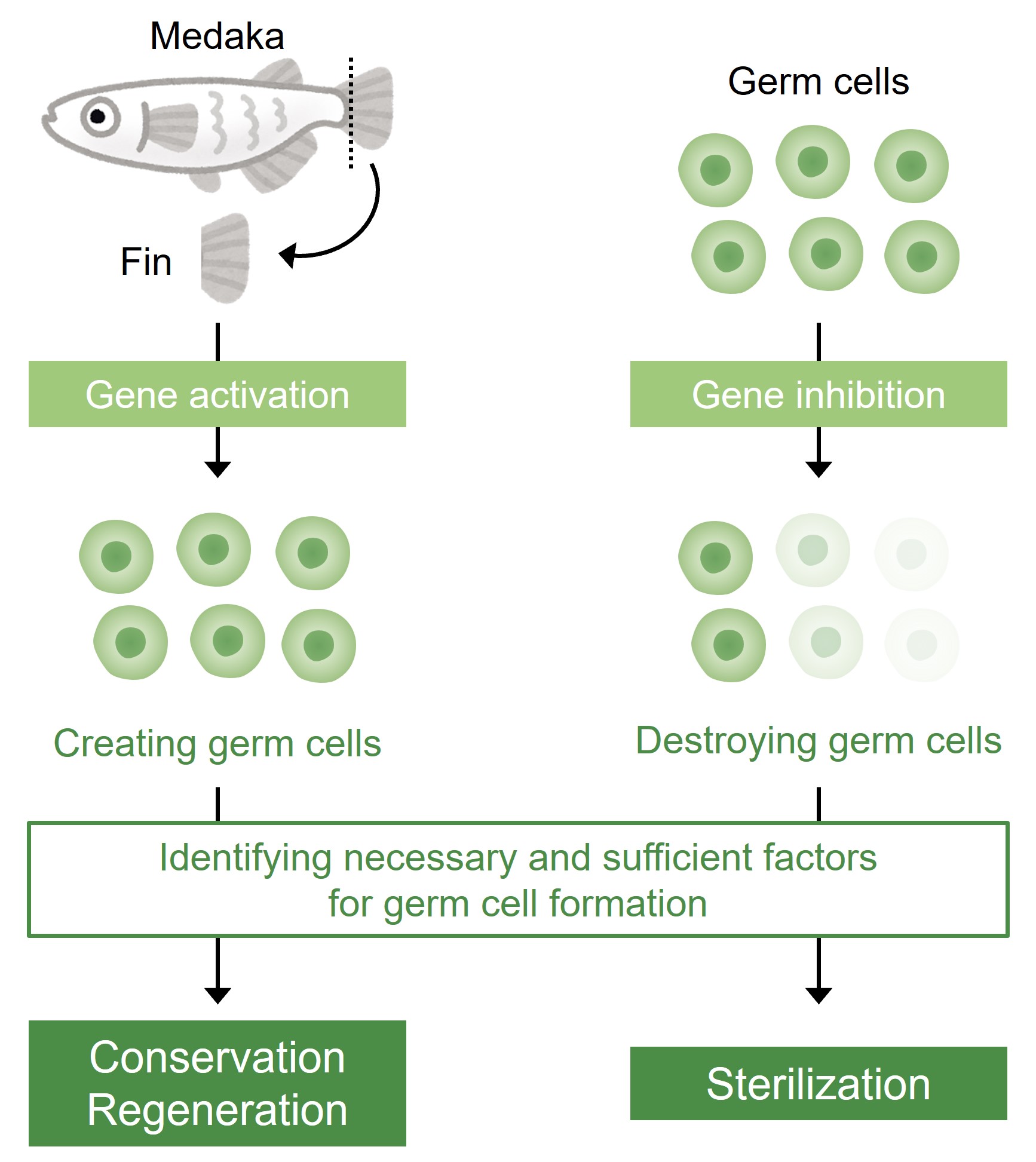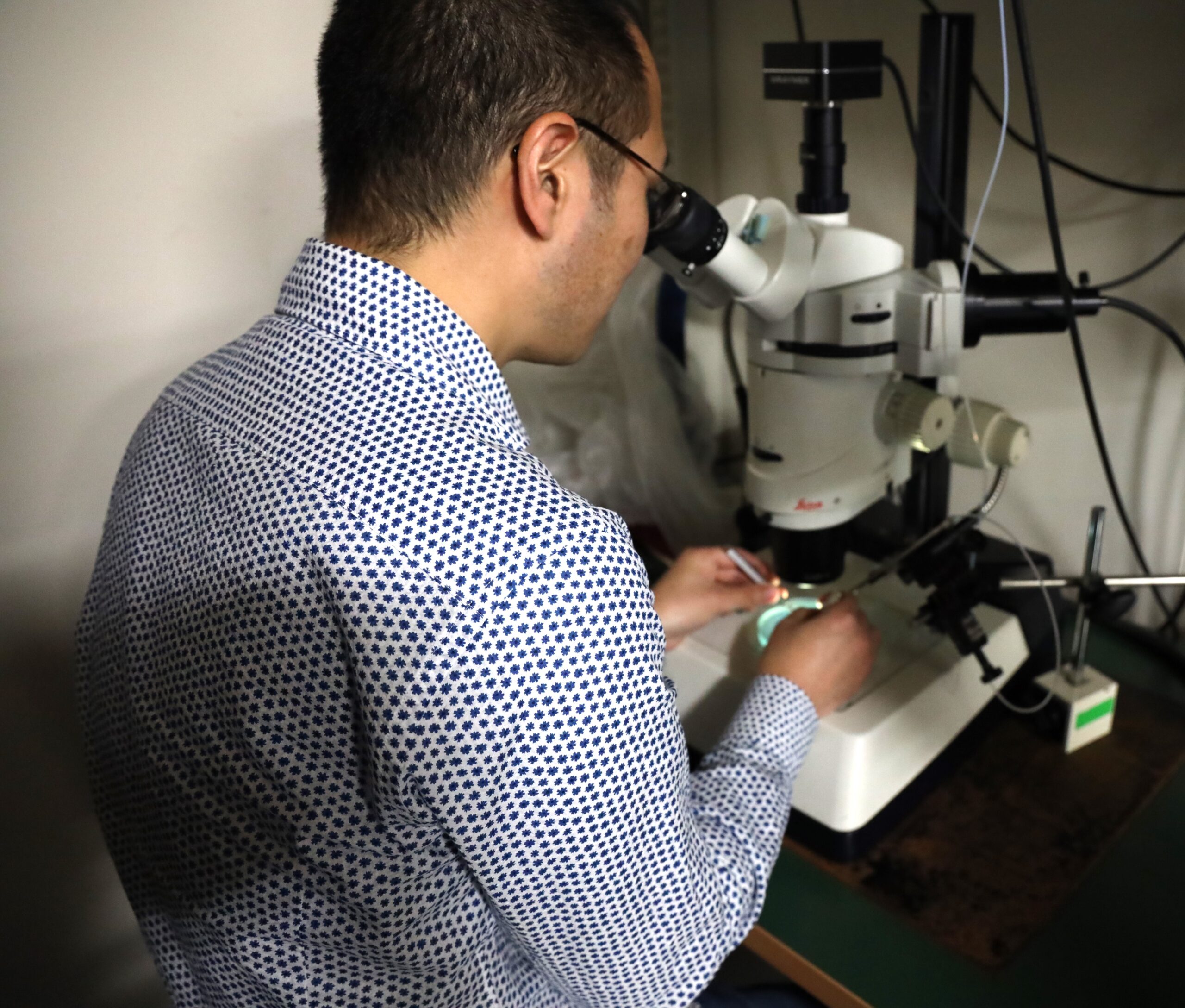Our lives begin with germ cells, sperm and eggs, which are then passed on to the next generation. How exactly are these germ cells formed? Dr. Toshiya Nishimura in the Faculty of Fisheries Sciences is trying to solve this mystery using a small fish, Medaka (Oryzias latipes).
From sex determination to germ cell formation
Q. How did you become interested in your current research?
As an undergraduate student, I was fascinated by the question of how biological sex is determined. My first encounter with germ cells occurred when I learned about the groundbreaking research of Dr. Minoru Tanaka at the National Institute for Basic Biology (currently a professor at the Graduate School of Science, Nagoya University). Dr. Tanaka and his team conducted experiments on medaka fish, focusing on the gonads, which are made up of germ cells and somatic cells. By removing the germ cells, they generated "empty" gonads consisting only of somatic cells. Remarkably, they discovered that removing germ cells caused genetically female medaka, which have XX chromosomes, to develop as males. 1 Conversely, by increasing the number of germ cells, genetically male medaka, which have XY chromosomes, developed as females. 2 These findings revealed that germ cells not only produce eggs and sperm but also play a critical role in determining the sex of the organism. This revelation deeply inspired me, leading me to pursue graduate studies in Dr. Tanaka's laboratory.
During my time in graduate school, I studied genes that function in the germline and identified a gene called foxl3 that determines "germline sex." 3 This gene functions in the female germline, and when it is disrupted, germ cells that would normally develop into eggs instead become sperm. Surprisingly, sperm were produced within the ovaries in female medaka. The determination of germ cell sex is thought to be predominantly influenced by the sex of surrounding somatic cells. The finding introduces a new concept: that germ cells can determine their own sex regardless of the surrounding somatic sex. This discovery earned me my Ph.D. and raised a new question in my mind: "Germ cells are much more 'active' than previously thought. How could germ cells actively determine not only their own sex but also influence the body's sex?" This question shaped the direction of my research. To further explore the nature of germ cells, I thought that it was crucial to understand how they are formed. This led me to studying "the mechanism of germ cell formation" when I joined Hokkaido University as an assistant professor.
Q. What kind of projects are ongoing in your lab?
We are currently pursuing two main research projects: one focused on "creating germ cells" and the other on "destroying germ cells."
The goal of the "creating germ cells" project is to transform somatic cells - which do not naturally become germ cells - into germ cells by introducing specific factors. We hypothesize that, in the early stages of germ cell formation, cells must exist in a pluripotent state - capable of becoming either germ cells or somatic cells. In fish, fins regenerate when cut, producing blastema cells essential for this process. Interestingly, studies have reported that genes expressed in pluripotent cells are also activated in blastema cells of fish fins. Based on this, we are exploring whether the unique regenerative ability of fish fins can be leveraged to create germ cells from blastema cells. For fisheries science, this research could lead to technologies for conserving genetic resources and regenerating individual organisms. Since cutting a fin does not kill the fish, this approach could potentially allow for the regeneration of critically endangered species with only one remaining individual in existence.
The "destroying germ cells" project, on the other hand, aims to develop technologies for sterilizing individuals. 4 Sterilization redirects the energy typically used for gamete formation toward overall body growth, resulting in larger individuals with improved meat quality. Additionally, with the rise of genetically modified (GM) fish in recent years, sterilization is crucial for preventing "genetic pollution," where hybridization with wild populations occurs if GM fish are accidentally released. Furthermore, sterilization plays an important role in surrogate production technologies. These techniques involve producing sperm or eggs of difficult-to-culture fish species (donors) in a more easily cultivated species (hosts). By sterilizing the host species to eliminate their own germ cells, we can efficiently produce only the donor's germ cells.
Although the ultimate goals of these two projects are diametrically opposed, they are interconnected. For example, if we identify a gene responsible for germ cell formation, we could introduce it into somatic cells to create germ cells. Conversely, by disrupting genes involved in germ cell formation, we could sterilize fish. By leveraging these approaches, I aim to integrate and advance both projects simultaneously.
Take action, then think about
Q. What do you value most in research?
I believe it's important to pursue things that I find interesting and enjoyable. When I met Dr. Takashi Iwamatsu, a renowned researcher on medaka (honorary professor at Aichi University of Education), he told me, "Take action, then think about." That advice has stayed with me ever since. Even if you have a good hypothesis, it will remain a hypothesis unless you act on it. Taking that first step - observing what happens - is essential. From there, you think about the results and move on to the next step. I believe research is a process built on this kind of repetition. Taking action is the critical first step not only for your research but also for your life in general. After all, you won't know until you try.

"The Integrated Book for the Biology of the Medaka", a textbook of medaka biology with the signature of Takashi Iwamatsu, the author of this book.
Q. How do you mentor students in your lab?
I believe problem-solving skills are the most important thing students can learn. Most of them will likely pursue careers outside academia, but the ability to overcome challenges and figure out solutions will be invaluable no matter where they go. To develop these skills, I emphasize the importance of identifying problems by organizing and summarizing the results they've obtained. To support this, starting this year, I've asked students in the lab to submit a weekly report of the experiments they've done. While I understand this might feel tough for the students, it allows us to review results and give them advice to guide their research directions.
Q, What are the strengths of conducting research in the Faculty of Fisheries Sciences?
One of the strengths of the Faculty of Fisheries Sciences is the wide variety of fish available for research. In addition to model fish like medaka and zebrafish, we also have access to commercial species such as rainbow trout, masu salmon, eels, and sturgeons. My aim is to establish a workflow where we uncover fundamental mechanisms using medaka and then apply those findings to commercial fish species. The Faculty of Fisheries Sciences at Hokkaido University provides an ideal environment for this kind of research.
Additionally, fish exhibit remarkably high genetic diversity, which means that what we discover in model fish doesn't necessarily apply to all fish species. This makes it exciting to conduct research in an environment where we can study a variety of species, potentially leading to discoveries distinct from those made in a typical biology department.
Research is all about passion
Q. How do you refresh your mind when you hit a roadblock in your research?
It's not uncommon to feel discouraged when things don't go well. In those moments, I try to reset by having a good meal, enjoying a drink, and taking some time to unwind. The next morning, I often find myself thinking, "Let's give it another shot." Of course, there's the occasional hangover, but it's worth it (laughs). When I was a graduate student, I had drinking buddies who helped me recharge and keep going. Many of them are still in academia, and we stay in touch. Sometimes, you might find an answer by sheer coincidence, even if you've been stuck for a while. The key is not to miss those moments of insight when they come.
Q. What would you say to someone aspiring to become a researcher?
When I was debating whether to pursue a career in research, I asked several researchers what they thought was most important for a scientist. A surprising number of them said, "Passion is key." I even remember one saying emphatically, "It's all about passion!" The feeling of excitement and curiosity - when something captures your interest and makes you feel thrilled - is what fuels research. I would encourage aspiring researchers to hold on to those moments of wonder, whether it's sparked by a lecture, a visit to an aquarium, or something else entirely. Keeping that sense of excitement alive, even in the back of your mind, is essential for driving your work forward.
Written by Josei Sato, Science Writing Intern, D3, Faculty of Life Sciences
(at the time of interview)
Photos by Josei Sato and Naoki Namba
References
- Kurokawa, H., Saito, D., Nakamura, S., Katoh-Fukui, Y., Ohta, K., Baba, T., Morohashi, K.-I., and Tanaka, M. (2007). Germ cells are essential for sexual dimorphism in the medaka gonad. Proc. Natl. Acad. Sci. U. S. A. 104, 16958-16963. https://doi.org/10.1073/pnas.0609932104.
- Morinaga, C., Saito, D., Nakamura, S., Sasaki, T., Asakawa, S., Shimizu, N., Mitani, H., Furutani-Seiki, M., Tanaka, M., and Kondoh, H. (2007). The hotei mutation of medaka in the anti-Müllerian hormone receptor causes the dysregulation of germ cell and sexual development. Proc. Natl. Acad. Sci. U.S.A. 104, 9691-9696. https://doi.org/10.1073/pnas.0611379104.
- Nishimura, T., Sato, T., Yamamoto, Y., Watakabe, I., Ohkawa, Y., Suyama, M., Kobayashi, S., and Tanaka, M. (2015). foxl3 is a germ cell-intrinsic factor involved in sperm-egg fate decision in medaka. Science 349, 328-331. https://doi.org/10.1126/science.aaa2657.
- Nishimura, T., Takahashi, E., and Fujimoto, T. (2024). Sterilization of fish through adaptable gRNAs targeting dnd1 using CRISPR-Cas13d system. Aquaculture 593, 741269. https://doi.org/10.1016/j.aquaculture.2024.741269.












